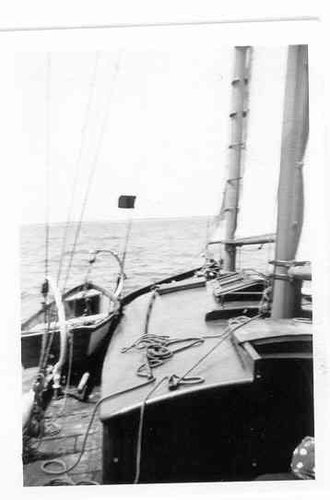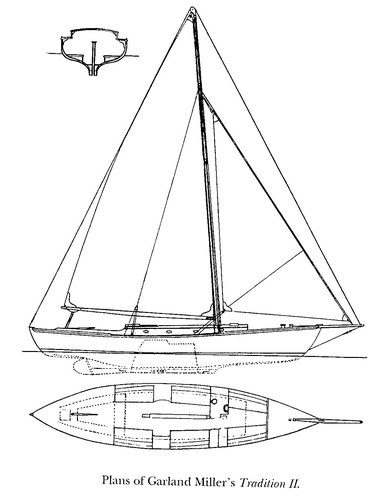| Jere Dennison
One could be excused for musing that the era of large cruising yachts at our Club is a present day phenomenon. However, a glance at the 1941 UYC Yearbook quickly reveals the fallacy of this notion. As of March 1, 1941, almost 45% of the entire Cruising Class fleet of 9 registered yachts measured over 50 feet in overall length. They were C. G. Kirkmeyers 58 schooner Windflower, B. O. Cones 58 ketch Jananne Lee II, H. V. Baldwins 53schooner Nighthawk, and Dr. George Z. Williams 51schooner Sea Toy II. Of these leviathans, Club archives yielded only a single photograph of Nighthawk...that is until recently. (Readers are invited to click on the History section of the FBYC Website to see the digital image of the schooner Nighthawk contained in the article titled as such.)
Sea Toy was prominent at the Club throughout the 1940s and into the early 1950s at Fishing Bay. Eventually, Dr. Williams, an esteemed research oncologist at the Medical College of Virginia, relocated to California to take a new position at another medical institution. Sea Toy was a wooden two-masted schooner, gaff-headed on the foresail and jib-headed on the mainsail. She had a centerboard that allowed her to work in shallow waters, to reduce drag on downwind legs, and to be careened for bottom cleaning and painting. Jimmy Reid remembers painting her bottom on a low tide on the sandbar off Stove Point in the early 1950s. Regrettably, we dont have comprehensive records from Sea Toys long and successful racing career, but we have brief glimpses of her past achievements from some old newspaper clippings contained in scrapbooks maintained by the Clubs first Historian, Mac Wellford. The August 10, 1947 Richmond Times-Dispatch noted that in 1940 the schooner Nighthawk narrowly defeated Sea Toy in the Clubs Long Distance Race to Tangier Island. The fleet was entirely comprised of the four 50-feet and over mega-yachts named above. Then in 1941, the results were reversed in the 1941 Long Distance Race to Hampton with Sea Toy winning handily.
Dr. Williams WinsDr. George Z. Williams, master of the schooner Sea Toy, which last Saturday won the UYCs Yorktown Race, has proved that sometimes it is a good idea to go against the rules of proper seamanship. Dr. Williams won the race by deliberately putting his 51-foot schooner smack on top of the flats at New Point and again over the York River slash; in fact he jumped from third to second place by taking such a long inshore tack at New Point, other contestants were sure that Toys bow would end up in the corn fields. Then following what sounds like a kind of jam, jerk and jump school of sailing, the skipper slid his big boat over the mud in the slash, tacking every time his board jumped up in the well. By these maneuvers he gained enough on the lead boat Euclid Hanburys sloop Halo out of HYC to rush into a surprise first.
Finally, the wind began to fill in from the northeast, and Sea Toy weighed anchor with the rest of the fleet out of sight. Eventually the wind was screaming at over 30 knots, and Sea Toy surfed through the night on a broad reach with centerboard retracted. After taking her time off Old Point Comfort (there was no R/C to finish the race in those days), she motored into Hampton Creek looking for the rest of the fleet. Surprisingly Sea Toy was the first to arrive...she had passed every other boat during the night, including J. Garland Millers Tradition II, the favored yacht out of Norfolk Yacht and Country Club. Other early records indicate that the Sea Toy participated in the Gibson Island Yacht Squadron Invitational Cruise in 1949, the Cruising Club of Virginias Old Point Race in 1951, FBYCs 13th Annual Regatta in 1952, and the Thimble Shoals to FBYC Race also in 1952. ...And a little bit of TraditionWell yes, I know, Tradition II was not an FBYC -flagged vessel, but she was so much a formidable racing threat on the lower bay and a frequent visitor at our Club events in earlier days, that she deserves mention here. Tradition II was built and sailed by J. Garland Miller out of NYCC. Garland was a champion Star boat sailor in the 1930s and log canoe champion, winning the title three years in a row at the Miles River Yacht Club beginning in 1937 in his first Tradition. Tradition II was probably constructed in the early 1940s. Richard Jud Henderson in his book, Chesapeake Sails: A History of Yachting on the Bay, records that Garland Millers second Tradition was a double-ended centerboard cruising racer that showed a definite kinship to the log canoe. Forty-seven feet long overall with a beam of 10 1/2 feet, she had draft of only 4 feet with the board up and a tiny rudder. Her hull shape was determined by Miller, who carved a 47-inch model of her. Lines and offsets were done by a crewmember, Charles Cox, who was a naval architect. No rule beater, Tradition II rated well up in class A (for large boats), but she was a real speedster and often overcame her high rating.When I was a young lad at FBYC in the late 50s and early 60s, the arrival of Tradition (the II is henceforth being dropped) was usually heralded in the following manner. Someone, milling about the dock or the lawn in front of the old clubhouse on regatta weekend, would intone reverently: Look...here comes...Tradition. Instantaneously all eyes rolled seaward. Unmistakably the beautiful beast would be headed toward the pier sailing smartly with a bone in her teeth. It was about to be showtime!
As she drew closer, you could discern the skipper with a firm confident hand on the tiller. Garland Miller was a wizened, battle-hardened sailor of the old school with hundreds or perhaps thousands of races under his belt. He was extremely elderly at this point, but you wouldnt know it from the intensity of the glow in his eyes. The crew, mostly youthful relatives, performed with military precision, possibly for fear of a flogging. Instinctively you knew that embodied in this figure at the helm was a force to be reckoned with in spite of the loss of both legs to diabetic disease. Finally at the last possible moment, Garland would throw the helm over hard, and Tradition would round up into the wind depowering her sails. And then her speed would slow, and gently oh so gently Tradition would come to a stop caressing the pilings at the exact spot chosen by the skipper. One would notice as the crew hurried to secure the boat for the night that there were no females aboard. The old skipper prohibited women...and whisky too. No-sir-ree, not ever on Tradition. That is until the crew bodily removed him from the cockpit (for, you see, there was no other way to transfer him to his wheelchair), and he was chauffeured home. Thats when a parade of girlfriends bearing coolers descended on Tradition for an evening of raucous revelry. I scarcely realized at the time that I was witnessing the end pf the era for the large, graceful wooden schooners, ketches, and sloops. They had all but vanished except for a few relics like Tradition that were holding on by their fingernails to the bitter end. Already molded fiberglass had supplanted wood as the hull of choice and was opening up the sport to many who could now afford cheaper, mass-produced, and lower maintenance racing yachts. But perhaps we are no longer creating as many legends as we once did when unique wooden sailing craft and their eccentric skippers ruled the waters of the Chesapeake Bay. |




